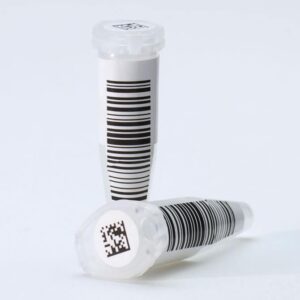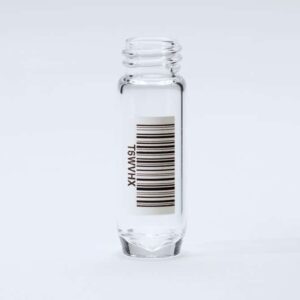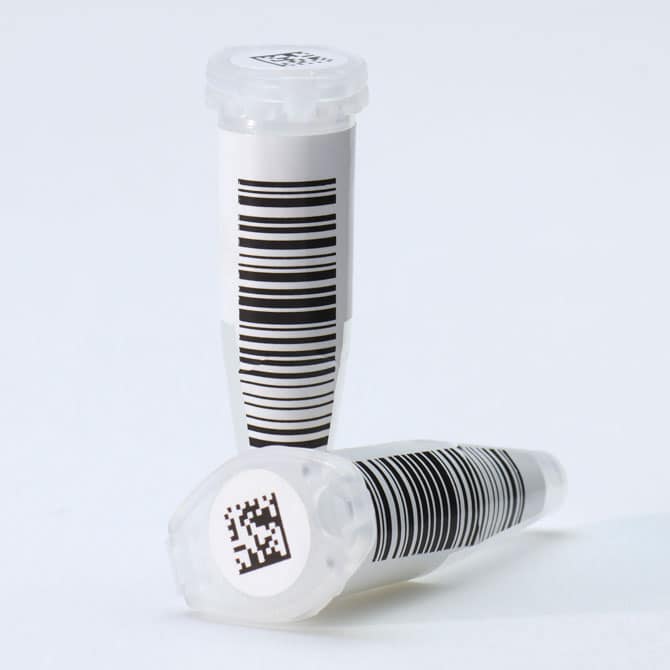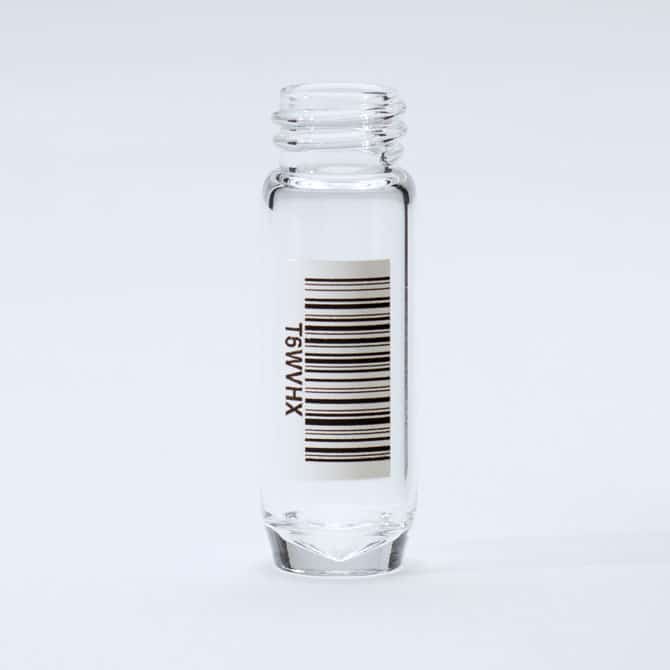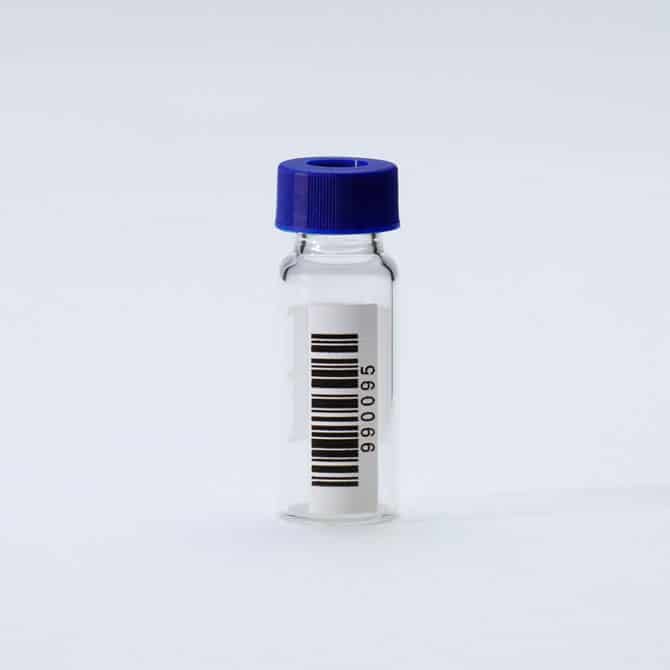In a lab setting, correct sample identification is crucial. Every lab should have a solution that improves the accuracy of research results and ensures efficiency. Your lab employees should be able to find what they need, when they need it and be confident it’s marked correctly. Workers in the field of diagnostics and drug discovery are directly impacting lives, leaving no room for mistakes or wasted time.
Depending on your application, environment and processes your ideal barcoding method will vary. Some labs benefit from permanent solutions, others can get by with disposable options that allow for on-the-spot printing and preparation.
Finding the right labeling solution for your lab is a simple way to streamline processes and preserve sample integrity, but first you need to know how to find your ideal match. This post will cover three labeling technologies, their benefits, downsides, costs and ideal applications so you can feel confident in making the right labeling decision for your lab.
Pressure sensitive labels
Traditional adhesive labels have been the most popular barcoding solution in healthcare for decades. They can be printed and applied in the lab by technicians and automation equipment, or they can be pre-printed and supplied directly to your lab. Over the years specialty labels have been engineered to withstand the chemical exposures and extreme temperatures the healthcare environment requires. However, despite pressure sensitive labels having come a long way, they are not a permanent solution.
What are the benefits of pressure sensitive labels?
Pressure sensitive labels have a number of benefits. To start there are a variety of different label materials and adhesive types, giving labs options to match their needs. If a lab needs a label that can withstand chemicals and extreme environments they can find one, and if another lab doesn’t they won’t need to invest in labels with those capabilities.
There are also options when it comes to obtaining your pressure sensitive labels, they can be outsourced or printed in-house. In cases where time sensitive or patient specific information needs to be recorded, printing pressure sensitive labels in house is the only option. For labs that prefer pressure sensitive labels and can opt to store only sequential information, outsourcing becomes a practical option that will give your employees more time to focus on research.
In addition to pressure sensitive labels being the most popular option for labware identification, they are also the most accessible. Pressure sensitive labels are typically available with short lead times and reasonable pricing.
What are the downsides of a pressure sensitive labeling strategy?
No matter how strong a label adhesive was engineered to be, it will never be permanent. Some are capable of withstanding years of exposure to chemicals, extreme environments and storage, but the more they come into contact with these things and the longer they are stored, the weaker the adhesive will become.
Adhesives and label materials are also often affected greatly by environmental changes which can impact their weight. If sample weight is an important factor in your lab, pressure sensitive labels may not be an ideal option as the weight of the labels can change over extended periods of storage.
Lastly, pressure sensitive labels add volume to the diameter of the containers they surround, though this might not impact all labs, some specific storage solutions (like racks for example) aren’t able to adapt to the increased diameter of tubes or vials with adhesive labels.
How much do pressure sensitive labels cost?
Since pressure sensitive labels have been the standard in most industries for decades, there are specially engineered labels for all kinds of purposes, even within single industries. Within healthcare alone there are very basic labels for samples with short life spans, labels with special laminates that can handle minor chemical splashes and synthetic labels that can be exposed to DMSO, thrown in the autoclave and stored for ten years.
Labels that are specially engineered to withstand harsh environments tend to be priced higher than standard paper labels due to their reliability and extended lifespan. Labels that aren’t made to last are typically priced lower since they require less in the way of engineering, and are often intended to be disposed of after a short period of time.
Which labs should use pressure sensitive labels?
The ideal lab for pressure sensitive labels is one where samples have a short lifespan or relatively low value. These samples may be stored cryogenically, placed in the autoclave or treated with harsh chemicals, but they won’t be kept around for decades and losing a sample due to poor label quality won’t create a serious loss or workflow interruption.
Additionally, in labs where variable data is critical, pressure sensitive labels are likely necessary since outsourcing only allows for pre-printed barcodes. That said, there are still high quality options and ways to improve how a pressure sensitive label is affixed to your containers.
Direct mark identifiers
Direct mark is a technology used to mark a container with a semi-permanent barcode or image. The barcode or image is printed right onto your plastic or glass containers using specialized inks or etching processes.
There are a variety of techniques that can be used in order to provide a thin ink coverage that doesn’t affect the outside diameter of the container. The two main categories of these techniques include laser imaging and direct ink transfer. Laser imaging typically involves a laser removing volume from the surface of the container while direct ink transfer involves placing and setting ink onto the surface of the container.
What are the benefits of direct mark?
In comparison to pressure sensitive labels direct mark is a much more permanent and durable barcode labeling option. Using this method ensures the barcode or image on your container will stand up to chemicals, extreme temperatures and extended periods of storage.
Tare-weighing is also much more reliable with direct mark. The inks or etch marks are not affected by humidity or other environmental factors allowing them to be accurately weighed after years of storage.
When inks are used, in combination with the ability to print 360 degrees some unique possibilities that other labeling strategies can’t offer are introduced. With direct mark additional markings can be added to your labware including graduation lines, color coding and brand specific information like logos.
What are the downsides of direct mark identifiers?
Even though direct mark will last through years of storage, extensive chemical and extreme temperature exposures, it’s not entirely permanent. Over time and extensive exposure to harsh conditions the bond between the inks and the container can weaken.
Unlike pressure sensitive labels, direct mark is difficult to replicate in the lab and requires an outsourcing partner to perform. This also implies time sensitive and patient specific information is not able to be printed if using direct mark since your labware will be barcoded & imaged prior to it arriving at the lab.
One way some labs have chosen to use direct mark despite needing variable information is by combining the direct mark strategy with a pressure sensitive strategy. This strategy is often used by labs that want to take advantage of the unique marking abilities of direct mark. They do this by ordering tubes and vials with grad lines, branding, and/or color coding from an outsourcing partner, then take care of the variable requirements in-house with pressure sensitive labels.
How much does direct mark cost?
Computype’s direct mark option is our ‘middle of the road’ option, both in permanence and price. Similar to pressure sensitive labels, this type of labeling strategy ranges widely in price.
Some labs can keep it simple and stick to black and white barcodes to save on cost while increasing permanence, however most labs are interested in direct mark because of the unique features it has to offer. The cost of direct mark depends entirely on the volume of labware, the amount of information printed on each piece, the type of direct mark technology being used, and whether or not color inks will be used.
That said, direct mark offers a lot of value to your lab. Since direct mark must be outsourced, your lab will save a lot of time and energy on manual and administrative work. This labeling solution is also very reliable when it comes to accuracy, preventing scanning issues throughout the automated workflow.
Which labs should use direct mark?
Labs looking for a more permanent alternative to pressure sensitive labels, wanting to incorporate branding or other markings (grad-lines, color coding, logo’s) onto their labware, or labs that want to eliminate labeling from their facility are great matches for direct mark. Facilities where storage is a concern, whether labels are too large for storage trays or falling off, are also a good match.
Ceramic identifiers
Ceramic identifiers are a permanent barcode solution specifically designed to be used with glass containers. A barcode printed onto a ceramic label is fired directly onto the container. The extreme heat binds the barcode to the container creating one solid component.
What are the benefits of ceramic identifiers?
When ceramic labels bond to a glass tube or vial they become a part of it, making it impossible to remove without damaging the container itself. This also makes vials marked with this technology incredibly reliable for tare weighing. The weight of a ceramic label can be trusted not to change over time, ensuring precise weight measurement. The ceramic make-up of these labels also gives them the ability to withstand extreme environments and harsh chemicals. Ceramic labels are able to withstand both extreme heat and extreme cold, ranging from about -80 degrees Celsius to 500 degrees Celsius. They are also unaffected by common lab chemicals.
What are the downsides of ceramic identifiers?
Despite these labels being our most permanent they do have a few drawbacks. First, the unique processes necessary for these labels to be made, printed and attached to your labware require time, attention and special equipment. This means, similar to direct mark, you will need to work with an outsourcing partner who will not have access to on-the-spot information and the lead times on ceramic labeled pieces will be longer than those of pressure sensitive or direct mark labeled labware.
Additionally, since the binding process includes both the vial and the label being fired in a kiln, ceramic labels can’t be applied to plastic labware and are only available for glass containers.
How much do ceramic identifiers cost?
Once again, the exact cost of ceramic identifiers is difficult to calculate without context, but due to their permanence, unique materials and preparation process they are a higher price tier option as compared to pressure sensitive and direct mark.
The value of ceramic identifiers lies primarily in their durability. Once the label becomes a part of the labware, it’s able to last as long as the container itself, offering reliable labeling that’s able to withstand just as much as the tube or vial.
Which labs should use ceramic identifiers?
In lab or compound storage settings where samples are extremely valuable and require use of chemical compounds and/or extended storage periods, ceramic labels can really prove their worth. In situations like these, label integrity can’t be compromised, if it is your lab could risk monetary loss. With ceramic labels permanence is ensured through extreme conditions and decades of storage.
Additionally, a consistent weight can be ensured with ceramic labels, making them a great choice when sample weight is critical. The decision to use ceramic labels can also benefit your lab by speeding up your processes. Outsourcing is required for this label method, so additional services such as tare-weighing and sorting can also be completed before your labware arrives.
Choosing the right partner
Your label supplier should learn about the processes your barcode solutions need to accommodate and what specifically you need your barcodes and labware to do.
The right supplier will consider factors such as automation, chemical exposure, temperatures, length of product life and the material construction of your containers, so they can issue a recommendation based on their knowledge of your processes.
Healthcare is a fast-paced and rapidly growing field, but one thing that will remain constant is the need for efficient and accurate identification. Today’s marking technologies are designed with your challenges in mind to help you achieve the right solution.
Connect with our labelling experts today
Blog article form
"*" indicates required fields
